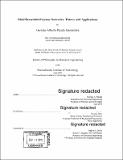Ideal reversible polymer networks : theory and applications
Author(s)
Parada Hernandez, Germán Alberto.
Download1138415547-MIT.pdf (17.76Mb)
Other Contributors
Massachusetts Institute of Technology. Department of Chemical Engineering.
Advisor
Xuanhe Zhao.
Terms of use
Metadata
Show full item recordAbstract
Hydrogels are crosslinked polymer networks with high water contents that can be designed to have similar properties as native tissue. Due to the tunability and unique properties of this class of materials, they are considered ideal biomaterials and have been explored for a variety of tissue engineering and biomedical applications. The widespread adoption of these materials outside research lab settings, however, has been hampered by multiple technical and non-technical limitations. We have addressed two of the technical limitations identified: Poor mechanical robustness and integration with non-hydrogel surfaces, and the lack of quantitative predictions of the hydrogel properties (based on the hydrogel's composition and structure). In this thesis we introduce a set of tough materials based on an interpenetrating network hydrogel architecture, and several strategies used to robustly adhere these materials to inorganic and elastomeric substrates. These strategies are used to introduce thin hydrogel layers on flat surfaces and selected medical devices. Subsequently, we characterize the mechanical, biocompatibility, antifouling, functional and blood compatibility properties of various coated surfaces, as compared to those of pristine surfaces, for medical device applications. Addressing the second limitation, we have developed an Ideal Reversible Polymer Network (IRPN) system that shows a single relaxation timescale due to the minimization of defects present on its structure. This system, which features 4-arm end-functionalized macromers with reversible crosslinks, enables predictions of its viscoelastic properties under shear deformation using Maxwell-based frameworks. The predictions are validated using a PEG hydrogel featuring boronic acid-diol reversible bonding and the data matches well the model predictions up to a critical strain boundary (which is estimated using scaling arguments). We hope this work enables the design and formulation of hydrogel-based materials and devices that can be employed to reduce clinical complications and healthcare-related challenges.
Description
Thesis: Ph. D., Massachusetts Institute of Technology, Department of Chemical Engineering, 2019 Cataloged from PDF version of thesis. "June 2019." Vita. Includes bibliographical references.
Date issued
2019Department
Massachusetts Institute of Technology. Department of Chemical EngineeringPublisher
Massachusetts Institute of Technology
Keywords
Chemical Engineering.